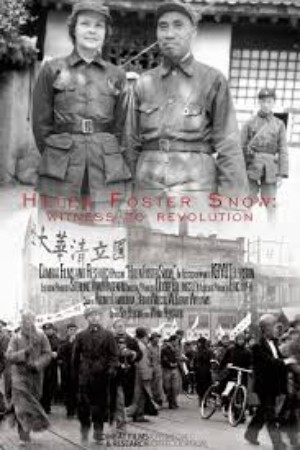
Helen Foster Snow: Witness to Revolution 2000
Distributed by Filmakers Library, 124 East 40th St., New York, NY 10016; 212-808-4980
Produced by Combat Films
Directed by Dodge Billingsley
VHS, color, 57 min.
High School - Adult
Women's Studies, Multicultural Studies
Date Entered: 11/09/2018
Reviewed by Linda Alkana, Department of History, California State University Long BeachIn 1931 Helen Foster Stone, eager to be a writer, left her native Utah at the age of 23 for Shanghai. Immediately welcomed into the relative privilege of the expatriate community, she soon became critical of that life, and found herself identifying more with Chinese intellectuals and students who were concerned about Japanese imperialism and Chinese independence. She revealed these views in letters to her family back home, all the while rising in the diplomatic ranks to become Social Secretary for the US Consulate.
In Shanghai she met and married American correspondent Edgar Snow, who shared her love of China and sympathy with the student movement. The two moved to Beijing in 1934 where Edgar taught at Yangjing University. Helen studied at the university and freelanced for American publications; their house became a meeting place for the student movement, which was becoming increasingly critical of Chiang Kai-shek. Helen Snow covered student protests and started writing anti-fascist articles that she would hand out to the students. Separately, both Edgar and Helen visited and interviewed Mao during the Long March. Helen became a regular correspondent for the international press and supported Edgar while he worked on his soon-to-be famous Red Star Over China. Helen’s own book of these experiences, Inside Red China, written while she was sick with dysentery and the Japanese were bombing Shanghai, was not as well received. Chinese students, however, read the book, and, in turn, headed to join the Long March.
With the destruction of Chinese industry by the Japanese, Helen Snow became a primary force behind Industrial Cooperatives, which combined wartime relief with cooperative production in inland China, away from the Japanese. She campaigned tirelessly and organized international support for these cooperatives, writing about them under her pen name Nym Wales. The Snows returned to the US during the war. Even during the Cold War and the changing relations between the US and China, Helen Foster Snow remained a supporter of China, escaping the McCarthy witch hunt against Communists and fellow travelers because of her relative anonymity. She wrote My China Years in 1984. Helen Snow died in Connecticut in 1997 and was eulogized in the US and China, where a permanent exhibit of her life has been installed in Xi’an.
Helen Foster Snow: My China Years is a 57 minute documentary that covers the life of Snow. Shot in both the US and China, it utilizes the vast Snow archives at Brigham Young University, and features interviews with both scholars and some of the former students Snow knew in China in the 1930s. The quality of the film is good, it is well edited, interviews are brief, voice-overs are appropriate, and the photographs of China in the 1930s from Snow’s collection and the National Archives are quite wonderful.
Although the film honors Snow and gives a glimpse into an extraordinary period of history and her part in it, the narrative tends to dwell too much on how she wasn’t given credit for the work of her husband. This issue is important, of course, but its emphasis, ironically, tends to overshadow Helen Foster Snow’s experiences and considerable accomplishments, which stand on their own, and merit a strong biography. Nevertheless, the filmmakers’ use of Snow’s archives and the images of China it presents should be valuable to students (high school on up) and those interested in Chinese history, 20th Century history, Women’s history and Chinese-US relations. Recommend.